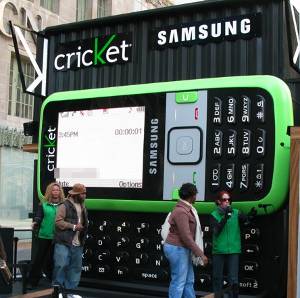

About a month ago I was at a neighborhood festival showing my art. I was directed to a small section called the "village" where there was a small live music stage and space for vendor tents, tables and art displays.
In front of me was a white and green canopy, which is rather ubiquitous in recent months at events such as this.
Honestly, this color combination got me confused for a couple of minutes. Was this Cricket Wireless, or Clear Wireless? They both have been heavily promoting at fairs and events like this, using almost the same modus operandi. The former is a cell phone company with an add-on mobile broadband Internet option; the latter is a WiMAX broadband Internet service. And they both use a very similar green-and-white branding schemes.
This is rather unfortunate. How many people are readily able to tell them apart when they see a green-and-white tent or a sandwich board sign?
Granted, they are not using exactly the same shade of green. Clear's green is approximately RGB (127, 195, 86), while Cricket's green is RGB (64, 181, 77). But how many people can distinguish them apart, especially when they are not next to each other? To excerbate the situation, Clear and Cricket are in the same industry, further contributing to confusion.
What can we learn from this?
1. Be very specific about color schemes when you are thinking of a branding makeover. Just like your alma mater has very specific school colors, your business must have specific colors that reflect who you are. A trivia: Portland State University and the University of Oregon are both green, but the former is RGB (101, 136, 26), the latter RGB (17, 111, 74).
2. Avoid confusing color schemes. When DHL rebranded back in 2004 following its merger with Seattle-based Airborne Express, many thought their delivery workers were from McDonald's. Within or without your specific industry, people perceive a certain combination of colors and associate it with something you don't want. Come up with unique combination of colors. Using a color wheel to find which colors complement one another. Haphazard combination of random colors can have a devastating effect as some colors are never meant to be seen together.
3. Have a corporate-wide guidelines on branding, including appropriate use of colors and typefaces. "Green and yellow" would be too vague and your employees may have a very different idea about green and yellow than what you might. It is also possible that employees and contractors might take an artistic license and modify your brand in such a way that it would no longer bear any resemblance. If you must, create a list of acceptable alternative colors -- especially one that uses only "web-safe" colors (i.e. 216-color palette) and for monotone colors (this would allow you to save money on printing and advertising expenses every once in a while). Ideally colors should be defined precisely by RGB, CMYK and hexadecimal numbers.




- Follow Us on Twitter!
- "Join Us on Facebook!
- RSS
Contact